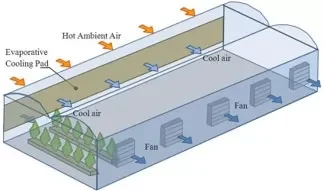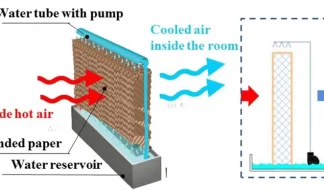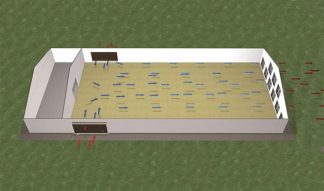Tecnical Details
Technical Details
| Maximum Height | 200 cm |
| Thickness of Honeycomb Paper that Can Be Used | 10 And 15 cm |
| Internal Water Tank | 36 liters / 1 meter |
| Circulation System Pipe Thickness | Ø 50mm |
| System Water Pump Power | 0.37 kW up to 36 meters |
| System Pump Capacity | 12 m3/hour at 8 meters |
- Includes an internal water tank, no need for external water tank
- The floating system allows automatic water refilling when the water level falls
- Adjustable length and height due to its modular structure
- The pads can be easily installed and uninstalled due to the special lock system
- In systems up to 18m, the pump is installed in the head section. In the middle for longer systems.
- System includes a drain valve for cleaning at the end of cycle.
- PVC raw material is anti-UV loaded
- Completely rustproof system
- More durable than alternative metal frame cooling systems as it is completely made of plastic.
Water Pump Technical Details

Customization Options for Different Applications
Agricultural Settings
Optimize cooling for poultry farms, greenhouses, and other agricultural facilities with specialized pad configurations and airflow patterns.
Residential Comfort
Customize the system to deliver whole-home cooling, focusing on energy savings and easy installation for homeowners.
Residential Comfort
Customize the system to deliver whole-home cooling, focusing on energy savings and easy installation for homeowners.
Agricultural Settings
Optimize cooling for poultry farms, greenhouses, and other agricultural facilities with specialized pad configurations and airflow patterns.
Understanding the Evaporative Cooling Principle

Evaporative Cooling Process
Evaporative cooling works by using the natural process of evaporation to lower the temperature of air. As water evaporates, it absorbs heat from the surrounding air, resulting in a cooling effect.

Continuous Water Supply
Evaporative cooling pads are constantly supplied with water, which is then evaporated by the airflow, providing a steady stream of cool, humid air.

Airflow Circulation
The system uses powerful fans to draw hot, dry outside air through the water-saturated cooling pads, creating a cooling effect as the air passes through.
Key Components of an Evaporative Cooling Pad System
Cooling Pads
The heart of the system, these pads are typically made from moisture-wicking materials like aspen wood fibers or cellulose. As air passes through, the pads absorb and evaporate water, providing a cooling effect.
Water Supply
A reliable water source, often from a tank or municipal line, continuously feeds the cooling pads to maintain optimal moisture levels and ensure efficient evaporative cooling.
Blower/Fan
High-efficiency fans draw in hot, dry air and push it through the water-saturated cooling pads, accelerating the evaporation process and distributing the cooled air throughout the space.
PVC Frame
A sturdy, lightweight PVC frame supports the cooling pads and allows for easy installation and maintenance, ensuring the system remains durable and functional over time.
Advantages of Evaporative Cooling over Traditional Air Conditioning
Evaporative cooling systems use up to 80% less energy than traditional air conditioning, making them a highly efficient and cost-effective solution.
Unlike HVAC systems that rely on refrigerants, evaporative coolers use water as the cooling medium, reducing water consumption and contributing to environmental sustainability.
The lower operating costs of evaporative coolers translate to significant long-term savings on utility bills, making them an economical choice for homeowners and businesses.
